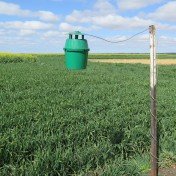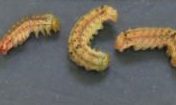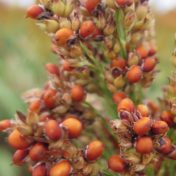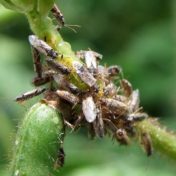Notes from the meeting at DAF, Monday 21 January 2019 The South Australian Research Institute (SARDI) leads the major GRDC investment in Russian Wheat Aphid (RWA) research in southern Australia. Dr Maarten van Helden and Tom Heddle (SARDI) were in the northern grains region conducting a survey of RWA in the ‘green bridge’ (roadside grasses) during January 2019 (GRDC project… Read more »
Monday 21 January at 8 am Green Room, QDAF Conference Centre, 203 Tor St, Toowoomba. In October 2018, detections of Russian wheat aphid (RWA) were made in Cowra, Forbes, and Condobolin on the Liverpool Plains, and Coonabarabran. NSW DPI Biosecurity reported these detections (read the document here). The map below shows the location of RWA detections in NSW. No detections have… Read more »
The 2018 spring Helicoverpa pheromone trapping program for the Northern Grains Region has recently concluded. The program, run by the Queensland Department of Agriculture and Fisheries for the Northern Grain Growing region, forms part of the national Helicoverpa monitoring network jointly run by DAF, cesar, SARDI, and DAFWA. The primary purpose of the trapping network is to detect high moth… Read more »
A new resistance management strategy (RMS) for Helicoverpa armigera has been released for the northern grain production region. It is anticipated that it will be adopted first in the current chickpea crop. H. armigera is a major pest of grain crops and presents a significant management challenge due to the current reliance on chemical control, and resistance to several insecticide… Read more »
As a part of a new insecticide resistance management strategy in grain crops, growers and agronomists are looking to rotate insecticides for Helicoverpa sp. control. Following enquiries from industry, DAF entomology have been conducting research on the range of newer insecticides available for controlling Helicoverpa larvae. In work previously published on the Beatsheet, we have demonstrated the efficacy of these… Read more »
As more growers and agronomists look to rotate insecticides for helicoverpa control in grain crops as part of a sound resistance management strategy, uncertainty about how to tell if larvae are actually dying, or had escaped control for some reason has emerged as a concern in some instances. These cases, where larvae have not died as quickly as expected, have… Read more »
The Helicoverpa pheromone trapping program has recently concluded for the 2017 Winter/Spring season. The program, run by the Queensland Department of Agriculture and Fisheries for the Northern Grain Growing region, forms part of the national Helicoverpa monitoring network jointly run by cesar, SARDI, and DAFWA. The primary purpose of the trapping network is to detect high moth activity, for both… Read more »
Sorghum is most susceptible to crop loss from insect pests during flowering and grain fill, and this article deals mostly with these species (sorghum midge, helicoverpa and Rutherglen bug). However, some years there may be pest infestations in vegetative sorghum. Vegetative sorghum During the vegetative stages you may see a few armyworm or helicoverpa larvae causing shot-holes in the leaves,… Read more »
Although typically only in low numbers in the Northern Grains region, Rutherglen bugs (RGB; Nysius vinitor) were observed at very high densities (e.g. 50 RGB per pod) in many crops last year. A glasshouse study was conducted to determine at what plant stage mungbeans were most susceptible to RGB damage, in terms of both yield and seed quality. To do… Read more »
Wireworm adults and larvae are relatively common soil pests, attacking all field crops. Adults feed on germinating shoots, and larvae feed on germinating seed, seedling roots and shoots causing poor plant vigour or death. Wireworms are most common in zero till, areas with high stubble, or weedy fallows. These are habitats and food sources that sustain the beetles and enable… Read more »






